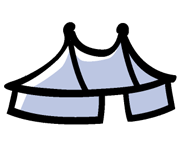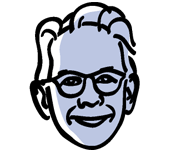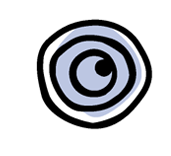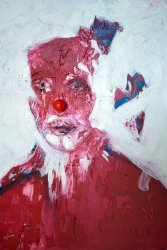A clown’s nose (july 2015)
The object that I want to talk to you about is so special that its presence qualifies its wearer and by this adornment, we know it perfectly.
This character may not wear this object which we might still see.
This object, so important, so special that even in its absence, it exists.
The actual absence of the object does not destroy it.
This particular object...
A mask.
It is the smallest mask in the world.
Sometimes even sculpted from the face by an excess of sweet wine against the harshness of life.
A simple planet lit by a scarlet sunset.
Scarlet? A bright, shining cherry on the white cake of another mask.
The buffoonish mask of old mattresses from street theatre, from their trestles.
A mask that is worn over the nose.
A nose that the clown carries over his soul.
A nose.
Of a clown.
A clown’s nose.
It’s the lifeline of he who is condemned to laughter, beatings, jeers and the natural evil of circus directors, children, their parents, the powerful and the unfortunate. This little mask is so important, so protective that even if the clown is not wearing it, it continues to exist, the nose, the soul, because of the wicked, the powerful and the unfortunate. Charlie Chaplin is the best example. Of a clown.
The clown. From the English “clod” meaning “peasant”, “settler” and by extension “rustic”.
The timeless costume of a particular kind of jester, a fearful, incompetent, whiny peasant. Invented by circus artists, gypsies, travellers and outsiders to mock, to avenge.
An earthly tramp turned into a heavenly tramp. As decided by living poetry all around the world.
This nose was born of a poor servant, a groom, a tailor from the English army who stumbled at every step in the sand and sawdust of the military arena where, in the late eighteenth century, shortly before the French Revolution in Paris, a non-commissioned English officer Philip Astley – accompanied by some reformed servicemen struggling in battle – performed somersaults on their horses prepared for the parade.
The first clown was called Billy Saunders.
And this new form of show was called “the modern circus”. That was in 1774.
The great film director Federico Fellini said that the clown was a shadow of man. He said: "When the sun of mankind is low on the horizon, the clown is great. When it is at its zenith, clowns will have gone”.
In 1984 circus arts underwent a revolution in France and Quebec. Cirque Plume and some other companies reinvented other forms of circus.
Ours, Cirque Plume, searches for poetry, fragility, encounters.
We play with light, with shadows.
On one day of rehearsals, a clumsy juggler in the company got tired of losing his ball so often and decided to juggle an invisible ball.
The light allowed the juggler’s shadow to project onto a white cloth in the background.
The juggler had nothing in his hand.
All the juggler was holding was an absence. This allowed him to bend down less often.
On the sheet behind him, in his hand, his shadow had a small red ball.
He let his shadow play.
He let his soul play.
Thirty years later, in July 2015, Cirque Plume is in Sao Paulo, Brazil.
The shadow of all clowns will forever be with us.
Whoever you meet on this occasion is wonderfully lacking a red nose but has lost none of the red-nose spirit.
Maybe they will continue to meet the joyful clown and its shadow?
The shadow of a man’s shadow.
In the dance of the presence-absence of such a pretty small mask, who lit up our childhoods.
This text was written at the invitation of the Bresilian newspaper « FOLHA DE S.PAULO ». The translated version was published on the website of the newspaper.
See the online publication http://www1.folha.uol.com.br/ilustrissima/2015/07/1659951-o-nariz-de-palhaco.shtml








